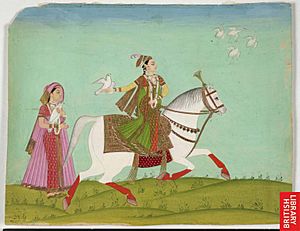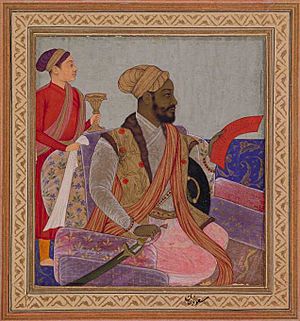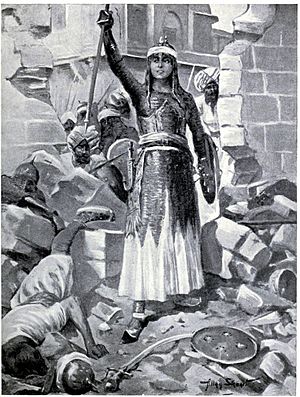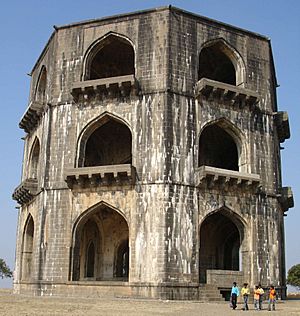Chand Bibi facts for kids
Quick facts for kids Sultana Chand Bibi |
|
|---|---|
| Regent of Bijapur and Ahmednagar | |

Chand Bibi hawking, an 18th-century painting
|
|
| Born | 1550 CE Ahmednagar fort |
| Died | 1599 CE |
| Spouse | Ali Adil Shah I |
| House | Nizam Shahi (by birth) Adil Shahi (by marriage) |
| Father | Hussain Nizam Shah I |
| Mother | Khunza Humayun Begum |
| Religion | Shia Islam |
Sultana Chand Bibi (1550–1599 CE) was a brave ruler and warrior from the Deccan region of India. She is famous for leading the defense of Ahmednagar against the powerful Mughal army in 1595. Chand Bibi served as a "regent" (meaning she ruled for a young king who was too young to rule himself). She was regent of the Bijapur Sultanate from 1580 to 1590, and later regent of the Ahmednagar Sultanate from 1595 to 1600.
Contents
Early Life and Education
Chand Bibi was born in 1550 CE. Her father was Hussain Nizam Shah I, the Sultan of Ahmednagar. She was also the sister of Burhan Nizam Shah II, who later became the Sultan of Ahmednagar.
Chand Bibi was very smart and learned many languages, including Arabic, Persian, Turkish, Marathi, and Kannada. She also enjoyed playing the sitar, a musical instrument, and her hobby was painting flowers.
Life in Bijapur
To create a strong alliance, Chand Bibi was married to Ali Adil Shah I, the ruler of the Bijapur Sultanate. Her husband even named a large stepwell (a well with steps leading down to the water) in Bijapur after her, calling it Chand Bawdi.
After her husband Ali Adil Shah I died in 1580, his nine-year-old nephew, Ibrahim Adil Shah II, became the new ruler. Since Ibrahim was so young, a general named Kamal Khan took control as regent. Kamal Khan was not respectful to Chand Bibi, and she worried he wanted to take the throne for himself. So, Chand Bibi worked with another general, Haji Kishvar Khan, to remove Kamal Khan from power. Kamal Khan was captured and removed from his position.
Kishvar Khan then became the new regent. He won a big battle against the Ahmednagar Sultanate. However, after the victory, Kishvar Khan became very greedy. He demanded that all the valuable captured elephants be given to him. This made the other generals very angry. Chand Bibi and the other generals then planned to remove Kishvar Khan. But Kishvar Khan found out about their plan. He had one of the generals, Mustafa Khan, captured and killed.
Chand Bibi tried to challenge Kishvar Khan, but he had her imprisoned in the Satara fort. Kishvar Khan tried to make himself king, but he was very unpopular. Other generals, led by Ikhlas Khan, marched to Bijapur, forcing Kishvar Khan to run away. He was later killed while in exile. After this, Chand Bibi briefly served as regent again.
Ikhlas Khan became regent, but Chand Bibi soon removed him. Later, he tried to take control again, but other generals challenged him. While Bijapur was having these problems, the sultans of Ahmednagar and Golconda attacked Bijapur. The Bijapur army was not strong enough to fight them alone. The generals realized this and gave up their power to Chand Bibi. She then asked for help from the Maratha forces. The Marathas attacked the enemy's supply lines, which forced the Ahmednagar-Golconda army to retreat.
Eventually, order was brought back to Bijapur. Dilavar Khan became the regent from 1582 to 1591. Once things were calm, Chand Bibi returned to her home in Ahmednagar.
Return to Ahmednagar
In 1591, the Mughal Emperor Akbar asked the four Deccan sultanates (including Ahmednagar) to accept his rule. They all refused. In 1595, the ruler of Ahmednagar, Ibrahim Nizam Shah, was killed in a battle. After his death, some nobles wanted his baby son, Bahadur Shah, to become king with Chand Bibi as his regent.
However, another minister, Miyan Manju, declared a twelve-year-old boy named Ahmad Nizam Shah II as the ruler. This caused more arguments among the nobles. Miyan Manju then made a big mistake: he invited Akbar's son, Murad Mirza, to bring his Mughal army to Ahmednagar. Murad came with other Mughal forces, and they marched towards Ahmednagar.
But while Murad was on his way, many nobles left Ikhlas Khan and joined Miyan Manju. Miyan Manju defeated Ikhlas Khan and his group. Now, Miyan Manju regretted inviting the Mughals, but it was too late. He asked Chand Bibi to become regent, and he left Ahmednagar with Ahmad Shah II. Chand Bibi agreed and declared Bahadur Shah as the new king of Ahmednagar.
Defending Ahmednagar
The Mughals invaded Ahmednagar in November 1595. Chand Bibi took charge and bravely defended the Ahmednagar fort. Her leadership was inspiring. After a while, the Mughal prince Murad offered to stop the attack if Ahmednagar gave up the region of Berar. Chand Bibi's troops were running out of food, so in 1596, she agreed to make peace and gave Berar to Murad. The Mughals then left.
Chand Bibi then asked her nephews, Ibrahim Adil Shah II of Bijapur and Muhammad Quli Qutb Shah of Golconda, to join forces against the Mughals. Ibrahim Adil Shah II sent 25,000 soldiers, and Golconda sent 6,000.
Chand Bibi had appointed a minister named Muhammad Khan, but he was disloyal. He secretly offered to surrender the entire Sultanate to the Mughals. Meanwhile, the Mughals started taking over areas that were not part of the Berar agreement. The combined armies of Bijapur, Ahmednagar, and Golconda fought a fierce battle against the Mughals in February 1597. The Mughals won, but they were too weak to continue their attack.
Because of arguments among their commanders, the Mughals pulled back. Prince Murad died shortly after. Emperor Akbar then sent his other son, Daniyal, and more troops. Akbar himself also came to the region.
In Ahmednagar, Chand Bibi faced new challenges from a minister named Nehang Khan. He had recaptured a town called Beed. In 1599, Akbar sent Daniyal and his generals to retake Beed. Daniyal avoided Nehang Khan's forces and went straight to the Ahmednagar fort, where his army began a siege.
Chand Bibi once again defended the fort. However, it was very difficult to resist the strong Mughal army. She decided to try and make a peace deal with Daniyal. Sadly, a nobleman named Hamid Khan, or perhaps her servant Jita Khan, spread false rumors that Chand Bibi was betraying the fort by negotiating with the Mughals. Her own troops, who were very angry and believed these lies, attacked and killed Chand Bibi. After her death, the Ahmednagar fort was captured by the Mughal forces after a siege of over four months.
Chand Bibi's Palace
There is a tomb in Ahmednagar that is locally known as "Chand Bibi ka Mahal" (Palace of Chand Bibi). However, this is incorrect. It is actually the Tomb of Salabat Khan II.




